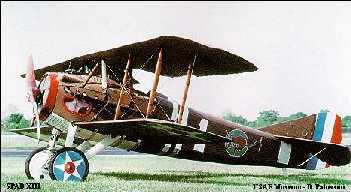 |
AIRCRAFTOF THEA E F |
Spad XIIIC.1

Development and OperationThe Société pour Aviation et ses Dérivés, developed its Spad VII 1916, but this aircraft was thought to be too lightly armed (only one machinegun). In response to this concern Louis Becheray designed a slightly larger and slightly heavier version; it was designated as the Spad XIII C.1. The new aircraft, which was originally designed for the new 220 hp Hispano-Suiza 8Ba geared engine. As engine development continued the Spad had its engine upgraded to the Hispano-Suiza 8Be engine. The prototype, number S.392, first flew at Buc in August 1917. The aircraft was of conventional construction with single-bay bracing with interplane struts. Its high aspect ratio wings gave it a high rate of climb. The aircraft was also characterized by a high diving rate. Its armament consisted of two 7.56mm Vickers machine guns. It rapidly went through testing and evaluations and so impressed French authorities that it was selected as the standard French pursuit aircraft for 1918. However, problems both with the Hispano-Suiza engine and production delayed deployment of the aircraft until 1918. The American Bolling commission recommended that the U.S. standardize pursuit aircraft production on the Spad XIII. This recommendation was accepted. However, all Spads purchased by the A.E.F. Air Service (833 were contracted for by the A.E.F. in February 1918) were French-built. In American service the Spads, which began to be received in July 1918, were assigned to almost all of the Pursuit Squadrons; replacing the earlier supplied Nieuports. Many of the U.S. Spads were fitted with Marlin machine guns |
Aircraft and Flight Characteristics
|
Engine |
Hispano-Suiza 8Be |
Span | 26 ft. ¾ inch |
Length | 20 ft. 4 inch |
Height | 7 ft. 6 ½ inch |
Fuel Capacity | 30 U.S. gallons |
Oil Capacity | 4 ½ gallons |
Armament |
2 Vickers machines or |
Weight Empty | 1,245 lbs. |
Petrol, oil, water | 242 lbs. |
Military load | 320 lbs. |
Weight Total | 1,807 lbs. |
Climb to: 2000 m. | 4 min. 40 sec. |
Climb to: 3000 m. | 7 min. 50 sec. |
Climb to: 4000 m. | 12 min. 10 sec. |
Climb to: 5000 m. | 18 min. 30 sec. |
Speed at: 2000 m. | 133.5 mph |
Speed at: 3000 m. | 132.8 mph |
Speed at: 4000 m. | 129.8 mph |
Speed at: 5000 m. | 126.1 mph |
References:
1. Profile Publication No. 17 SPAD XIII C.I
2. French Aircraft of the First World War
by Davilla, Dr. James and Arthur M. Soltan
To find other Doughboy Features visit our |
Membership Information  Click on Icon |
For further information on the events of 1914-1918
visit the homepage of |
Michael E. Hanlon (medwardh@hotmail.com) regarding content,
or toMike Iavarone (mikei01@execpc.com) regarding form and function.
Original artwork & copy; © 1998-2000, The Great War Society